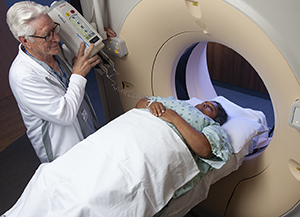PET Scan
A PET scan is a diagnostic imaging test. It's a type of nuclear medicine procedure. This means it uses a tiny amount of a radioactive substance, called a tracer, to look for problems in the body. Typically, this test is used to check for the presence of cancer. A PET scan can also be used to check organs such as your heart and brain. It can also look at specific body tissues like lymph nodes. Some other imaging tests show the structure of a body part. But a PET scan shows changes in how an organ or tissue works. This can help your healthcare provider diagnose problems and create a care plan for you.
Why a PET scan is done
PET scans are often done to help diagnose or manage some conditions. These include:
Getting ready for a PET scan
You will be told how to get ready for your scan. It's important to follow these instructions carefully. If you don't, the test may not be accurate. You may need to take the test again.
You may be told to:
-
Not eat for at least 4 to 6 hours before the scan. This includes gum and mints.
-
Drink plenty of water before the scan.
-
Not drink any liquids that have sugar or calories. This includes soda, juice, energy drinks, sweetened bottled water, and alcohol.
-
Avoid any strenuous activities or exercise for 24 hours before the test. These activities may interfere with your test results.
Tell your healthcare provider about any recent illnesses, all medical conditions, and all medicines you take. Ask if you should take the medicines as usual before your exam. You may need to stop taking them before the test. This includes:
-
All prescription medicines
-
Over-the-counter medicines such as aspirin or ibuprofen
-
Street drugs
-
Herbs, vitamins, and other supplements
Also tell your healthcare provider if you:
-
Are pregnant, or think you could be
-
Are breastfeeding
-
Have ever had an allergic reaction to X-ray dye (contrast medium)
-
Have diabetes. You will be given special instructions regarding your medicines and food intake.
Follow any other instructions from your healthcare provider.
During your procedure
-
Tell your healthcare provider if you are afraid of small spaces. This is called claustrophobia. You may be given medicine called a sedative to help you relax before the test.
-
You will be given a tiny amount of a radioactive substance called a tracer. This will be given through an IV line in a vein in your arm or hand. While your body absorbs the tracer, you will rest quietly on a table or in a reclining chair for 30 to 60 minutes. Once the tracer is absorbed, the scan can be done.
-
If you are having a CT scan done at the same time, you may be given X-ray dye, also called contrast medium. It will also be given through an IV.
-
For the scan, you will lie on a cushioned table that will slide into the scanner. The scan itself takes 30 to 90 minutes. During that time, try to stay as still as possible. Move only when you are told.

After your procedure
-
If you were given a sedative, have an adult friend or family member drive you home.
-
Over the next few hours, drink plenty of clear fluids. This will help flush the tracer out of your body.
-
The radioactive material in the tracer will not harm your loved ones.
Possible risks
-
Radiation exposure. A PET scan has a typical exposure level for medical diagnostic tests. It's felt to be safe.
-
Allergic reaction to the injected tracer or X-ray dye. This is rare, but may occur.
© 2000-2025 The StayWell Company, LLC. All rights reserved. This information is not intended as a substitute for professional medical care. Always follow your healthcare professional's instructions.